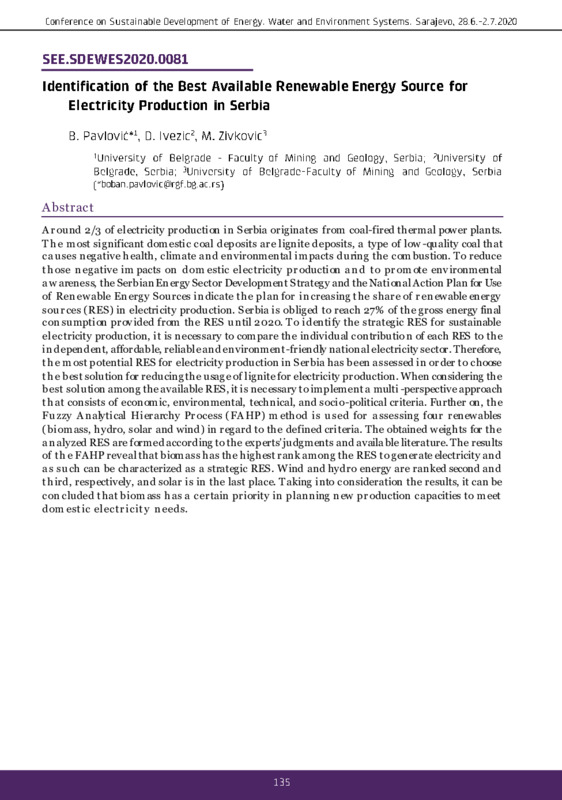Identification of the Best Available Renewable Energy Source for Electricity Production in Serbia
Објеката
- Тип
- Саопштење са скупа штампано у изводу
- Верзија рада
- објављена
- Језик
- енглески
- Креатор
- Boban Pavlović, Dejan Ivezić, Marija Živković
- Извор
- Conference on Sustainable Development of Energy, Water and Environment Systems, Sarajevo, 28.6.-2.7.2020.
- Издавач
- Faculty of Mechanical Engineering and Naval Architecture, Zagreb
- Датум издавања
- 2020
- Сажетак
- Around 2/3 of electricity production in Serbia originates from coal-fired thermal power plants. The most significant domestic coal deposits are lignite deposits, a type of low -quality coal that causes negative health, climate and environmental impacts during the combustion. To reduce those negative impacts on domestic electricity production and to promote environmental awareness, the Serbian Energy Sector Development Strategy and the National Action Plan for Use of Renewable Energy Sources indicate the plan for increasing the share of renewable energy sources (RES) in electricity production. Serbia is obliged to reach 27% of the gross energy final consumption provided from the RES until 2020. To identify the strategic RES for sustainable electricity production, it is necessary to com pare the individual contribution of each RES to the independent, affordable, reliable and environment-friendly national electricity sector. Therefore, the most potential RES for electricity production in Serbia has been assessed in or der to choose the best solution for reducing the usage of lignite for electricity production. When considering the best solution among the available RES, it is necessary to implement a multi-perspective approach that consists of economic, environmental, technical, and socio-political criteria. Further on, the Fuzzy Analytical Hierarchy Process (FAHP) method is used for assessing four renewables (biomass, hydro, solar and wind) in regard to the defined criteria. The obtained weights for the analyzed RES are formed according to the experts' judgments and available literature. The results of the FAHP reveal that biomass has the highest rank among the RES to generate electricity and as such can be characterized as a strategic RES. Wind and hydro energy are ranked second and third, respectively, and solar is in the last place. Taking into consideration the results, it can be concluded that biomass has a certain priority in planning new production capacities to meet domestic electricity needs.
- почетак странице
- 135
- крај странице
- 135
- issn
- 2706-3682
- Subject
- Strategija obnovljive energije, Održiva energija, Proizvodnja električne energije, Solarna energija, Biomasa, Hidroenergije, Energija vetra
- Renewable Energy Strategy, Sustainable Energy, Electricity production, Solar, Biomass, Hydropower, Wind power
- Шира категорија рада
- М30
- Ужа категорија рада
- М34
- Права
- Отворени приступ
- Лиценца
- Creative Commons – Attribution-NonComercial-Share Alike 4.0 International
- Формат
- Медија
 SEESDEWES2020_BoA-136.pdf
SEESDEWES2020_BoA-136.pdf
Boban Pavlović, Dejan Ivezić, Marija Živković. "Identification of the Best Available Renewable Energy Source for Electricity Production in Serbia" in Conference on Sustainable Development of Energy, Water and Environment Systems, Sarajevo, 28.6.-2.7.2020., Faculty of Mechanical Engineering and Naval Architecture, Zagreb (2020) М34
This item was submitted on 15. јул 2021. by [anonymous user] using the form “Рад у зборнику радова” on the site “Радови”: http://gabp-dl.rgf.rs/s/repo
Click here to view the collected data.